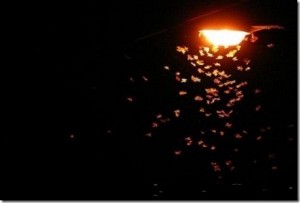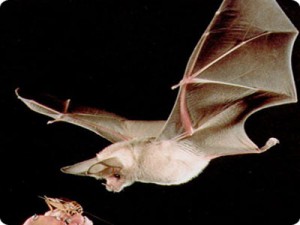Everybody knows that moths are attracted to human light at night like, well, a moth drawn to a flame. However, what scientists are beginning to discover is that this fatal attraction is more harmful than previously thought! Researchers out of the University of Pretoria found that moths in an artificially lit environment were significantly more likely to be eaten by bats than moths in a naturally dark environment were.

“Drawn like moths to a flame”, a well known saying about fatal attraction, may prove to be more rooted in science than previously thought, thanks to Corneile Minnaar & colleagues.
For the past 65 million years that moths and bats have coexisted on earth they have evolved competing adaptations to get an edge on their respective side of the predator-prey relationship. Bats, of course, have evolved ultrasound echolocation that helps them locate prey without visual cues. However, to compete evolutionarily, some species of moth have evolved ultrasound-sensitive ears. These eared moths can detect, in hopes of evading, standard bat echolocation calls using flight maneuvers and echolocation-jamming calls.
These defensive responses are lowered when the moths do not need to utilize their nocturnal cues, such as when exposed to artificial light. Unfortunately for moths, artificial light is becoming increasingly ubiquitous. In fact, it is estimated that Earth’s night-time surface brightness has doubled in the last 20 years.
To better study the effect of lit environments on this predator-prey relationship, Corneile Minnaar and colleagues compared the diets of Cape Serotine bats (Neoromicia capensis) in artificially lit and naturally unlit conditions. They found that the bats were eating up to six times more moths in artificially lit conditions than in dark ones. What makes this statistic even more notable is the relative abundance of nocturnal insects in the lit and unlit environments– moths made up a smaller fraction of the nocturnal insects in the lit environments than they did in the unlit ones. That is to say that these bats consumed a disproportionally high number of moths in artificially-lit environments.

Neoromicia capensis, or a Cape Serotine Bat, about to make a tasty meal out of an unlucky nocturnal insect. Normally, this species of bat does not consume many moths, but artificial light may be giving these, and other ultrasound-echolocators, a leg (er, wing?) up.
To corroborate their field study, and propose an explanation for these marked dietary differences, Minnaar and colleagues designed a series of mathematical models predicting the diet of Cape Serotine bats. These models took into account a variety of prey-selection factors, including the likelihood of prey encounter, detection, and capture given prey’s evasive behavior. Additionally, they considered how likely each type of prey was to be actively sought out by the predator, due to size, taste, and energy- content. The theoretical models that most closely matched the experimental results were the ones that supposed the moths successfully evaded bats under naturally dark conditions, and did not do so under lit conditions.
What these results propose are that eared-moths’ defensive behaviors, which are highly effective in dark conditions, are lowered or absent in artificially lit conditions. One hypothesis the researchers propose is that since moths can see more in lit conditions, they rely less on their defensive adaptations for survival, though further research must be done for a conclusive explanation. What is clear from the study, however, is that eared-moths are being eaten at a disproportionally high rate when exposed to artificial light. This poses a serious risk of survival to eared-moths when considering the exponential rate at which Earth is being urbanized and artificially lit.
References:
Minnaar, C., Boyles, J. G., Minnaar, I. A., Sole, C. L., McKechnie, A. E. (2014), Stacking the odds: light pollution may shift the balance in an ancient predator–prey arms race. J Appl Ecol.
